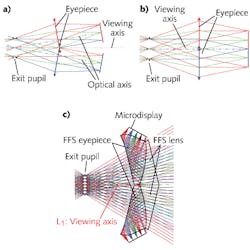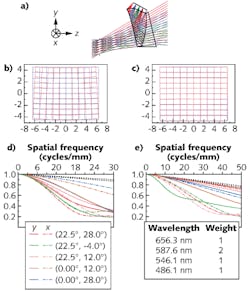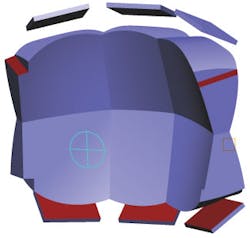OPTICAL DESIGN: Free-form optics enable lightweight, high-performance head-mounted displays
DEWEN CHENG, YONGTIAN WANG, HONG HUA, and JOSÉ SASIÁN
A head-mounted display (HMD) is a display device worn on the head that has a small display optic in front of each eye. It is difficult to achieve a wide field of view (FOV) and high resolution in conventional HMD designs with a single display channel per eye; a tradeoff has to be made between FOV and angular resolution, due to the well-known FOV-resolution invariant, in which an HMD can have wide FOV or high resolution but not both at the same time.
Several approaches have been proposed to overcome the FOV-resolution invariant, including high-resolution area of interest, partial binocular overlap, dichoptic area of interest, and tiling, each of which has merits and drawbacks.1 Other researchers have tried to use a high-end microdisplay and optics to obtain a wider FOV and high-resolution HMD.2 The fabrication and alignment of such a system are very difficult, and the high-resolution microdisplay devices are very expensive. Except for the tiling method, all the other methods offer only partial solutions to the FOV-resolution invariant problem.3
Tiling method
All the existing tiled HMDs are based on rotationally symmetrical design principles. They suffer from problems that limit their acceptance for many applications. For example, because the optical axis of each of the tiled display channels does not coincide with the viewing axis of the eye, seams or vignetting-like artifacts may be visible at the transition regions of adjacent display channels unless the images on the microdisplays can be rendered according to the eye movements, and image magnification decreases gradually from the center to the edge of the tiled display—known as perspective distortion.4 Moreover, existing tiled systems are typically heavy and bulky. And finally, in these optical designs it is almost impossible to accommodate the optical see-through capability required for augmented-reality applications, where a nonblocked real-world view is crucial.
Free-form optical surfaces offer more degrees of freedom for optical design, and can help to simplify the structure of the system and reduce its size and weight, which is very important for HMDs. We proposed a novel tiled HMD, which takes full advantage of free-form surfaces (FFSs) and an off-axis configuration to make the system compact and lightweight, and to make the viewing axis coincident with the optical axis of each display channel.5
See-through capability
This design eliminates most of the critical problems that exist in a conventional tiled HMD. More importantly, it is able to achieve an optical see-through capability by adding a free-form compensation lens. This tiled HMD with the see-through feature is formed by two special designed FFS prisms tiled at their bottom surfaces and an FFS compensation lens (see Fig. 1).An FFS prism eyepiece with an FOV of 45º × 32º is used as the starting point for the design of the tiling elements.6 An 8º overlapping FOV is allowed in the tiled direction to minimize the vignetting effects in the transition region. Therefore, the design example shown in Fig. 1c has an FOV of 56º × 45º and an angular resolution of 3.2 arcmin. The size of the tiled prism is 44 × 25 × 17 mm with an overall weight less than 20 g. The eye clearance is 18 mm and the eye relief is 25 mm (see Fig. 2).
The FFS prisms can also be tiled at their side surfaces so that more prisms can be tiled together to form an HMD with an even wider FOV. An example is shown in Fig. 3 in which six prisms are used to provide an FOV as large as 119º × 56º.Design of free-form optical system
It is clear that high-performance HMDs with an eyeglass-like style can be achieved by tiling FFS prism eyepieces. The use of FFSs in an optical system, however, may cause a dramatic increase in the complexity of the design and optimization process. Inappropriate and inadequate presentation and optimization methods for the free-form optical system may lead to discouraging and unpredictable results.
A suitable representation method must a) provide adequate degrees of freedom; b) require reasonable amount of ray-tracing time; and c) offer reliable convergence in the optimization process. In the CODE V optical design software, anamorphic aspherical surface (AAS) and XY polynomial surface (XYP) are the two surface types often used to describe an FFS. The XYP surface type can often achieve significantly lower error function and better image quality than the AAS representation. This is because an AAS surface has two planes of symmetry, whereas an XYP surface can be tailored to have one plane of symmetry and thus offer more degrees of freedom to the optical design process.
On the other hand, the ray-tracing speed of an XYP surface is significantly slower than the standard AAS method. Furthermore, the derivative errors of an XYP surface that are typically accumulated during the optimization process can often push the optimization into ill-defined conditions and force the termination of the optimization process without yielding a valid solution. In contrast to the XYP method, it is much faster and more reliable to obtain a good design employing the AAS type of surface.
Progressive design strategy
In the common cases when a starting point is not available for an FFS, we suggest using the following progressive design strategy.6 The surface should first be optimized with a spherical type to obtain the correct first-order parameters. The spherical surface can then be converted to an aspheric (ASP) type by adding a conic constant and the fourth-order or higher aspheric coefficients. Following an intermediate state of optimization, the ASP-type surface is converted to an AAS-type surface for better correction by directly adding asymmetric coefficients. Optimization with the AAS-type surface helps to create a good starting point. The AAS surface is then converted to the XYP type through a fitting algorithm such as the least-squares method for the final stage of optimization. High prevision (forecasting ability) is required for the fitting algorithm to avoid a significant deviation from the starting design produced by the AAS surface type.
In the final stage of lens design, it is usually a critical step to balance the optical performance of a lens system across the sampled fields, which is achieved by adjusting the weights to these fields. For a design with FFSs and an asymmetric configuration, more fields have to be sampled to accurately describe the aberration characteristics and the system performance. The sampling has to cover the entire FOV instead of being represented by a single (tangential) section because of the asymmetry. It is difficult for a designer to decide the weights for so many fields, which is one of the reasons why optical design is so time-consuming and heavily dependent on the designer’s experience.
Addition of an outer loop
An automatic image performance balancing scheme is therefore proposed.7 An outer loop is added in the optimization process, in which the weight for each field and azimuth is calculated appropriately according to the actual performance of the current design and the system requirements, and adjusted automatically before each optimization trial. The scheme can usually achieve performance balancing across the FOV with several automatic optimization trials, and can often improve the overall performance of the system.
The successful optimization of the wedge-shaped FFS prism also depends on the correct setup of numerous constraints.6 For example, total internal reflection (TIR) constraints and anti-TIR constraints are required to form a correct ray path; additional structure constraints are required to ensure that the three surfaces together maintain a valid prism shape with desirable center and edge thickness; special distortion controls are also required because conventional distortion values based on paraxial calculation are not valid for a nonsymmetric system.
REFERENCES
1. J.E. Melzer, “Overcoming the field-of-view/resolution invariant in head-mounted displays,” Proc. SPIE, 3362, 284 (1998).
2. K. Inoguchi et al., “The development of a high-resolution HMD with a wide FOV using the shuttle optical system,” Proc. SPIE, 6955, 695503 (2008).
3. J.P. Rolland and H. Hua, “Head-mounted display systems,” in the Encyclopedia of Optical Engineering, R.G. Driggers, ed., Taylor & Francis (2003).
4. D. Cheng et al., “Large field-of-view and high resolution free-form head-mounted display,” Proc. SPIE, 7652, 76512D (2010).
5. D. Cheng et al., Opt. Lett., 36, 11, 2098 (2011).
6. D. Cheng et al., Appl. Opt., 48, 14, 2655 (2009).
7. D. Cheng et al., Opt. Exp., 18, 11, 11574 (2010).
Dewen Cheng is a PhD student and Yongtian Wang is professor of optics from the School of Optoelectronics, Beijing Institute of Technology, Beijing, China. Wang may be contacted at [email protected]. Hong Hua is associate professor of optical sciences and José Sasián is professor of optical sciences from the College of Optical Sciences, University of Arizona, Tucson, AZ.


